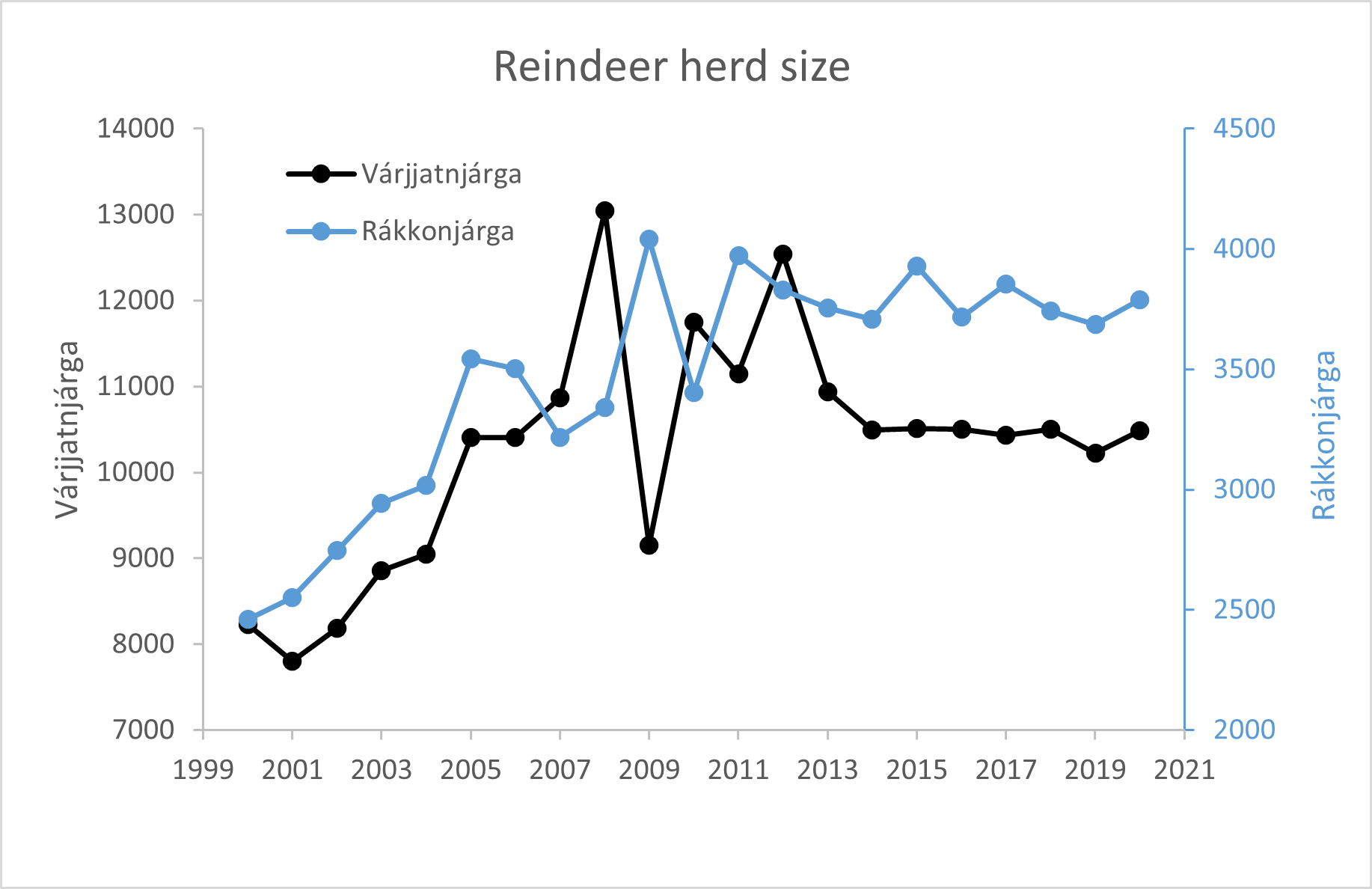At the end of the last glaciation the ice retreated relatively early in Varanger (Hughes et al. 2016), and 12 000 years ago both wild reindeer and humans had colonized the area. Semi-domestic reindeer became dominant in the 17th century.
Today the Varanger peninsula is used as summer pastures by two reindeer herding districts, with winter pastures located further south towards the Finnish border. The Várjjatnjárga reindeer district use the central and eastern parts of the Varanger Peninsula, while Rákkonjárga reindeer district use the western side of the peninsula. Towards the end of the 20
th century reindeer herd sizes declined in Finnmark, partly due to severe winter conditions and partly as a result of high reindeer numbers at the end of the eighties and beginning of the nineties (Hausner et al. 2011). Since then, both districts have increased their herd sizes and today reindeer numbers are relatively stable at close to 10500 in Várjjatnjárga and 3700 in Rákkonjárga. This represented 6.7 % of the total semi-domesticated reindeer population in Norway in the 2020/2021 season. The reindeer districts on Varanger Peninsula have high productivity and harvest a relatively large proportion of their annual calf production. As such, they contributed with 10 % (137 000 kg) of the national production of reindeer meat in the 2020/2021 season. The reindeer herds in Varanger are expected to be sensitive to snow conditions in winter and spring and the annual production of edible plants and lichens. In addition, the herders are concerned about losses to predators and increasing pressure from other land use interests, including wind farms, mining and motorised recreational users.
Rock carvings suggest that moose were important to humans in Finnmark in the stone-age, 7000 years ago. However, in early 20th century the moose population was extinct, and subsequent recolonization and population growth has predominantly occurred in the latter half of the 20th century. Today the moose population is managed through hunting. The moose population in Varanger has shown an increase in population size also in the 21st century, with associated decrease in slaughter weights and the proportion of female moose that give birth to twins. At present (2022) it is a small population of roe deer (Capreolus capreolus) in the Tana valley. The population may expand in response to climate change.
 Herd size development in the two reindeer districts on Varanger peninsula since the turn of the century. (Note the different scales on the two y – axes.)
Herd size development in the two reindeer districts on Varanger peninsula since the turn of the century. (Note the different scales on the two y – axes.)
Expected climate impact
Climate change is expected to have both negative and positive effects on ungulates. Warmer and wetter winters will make episodes with rain in winter more common. Such events can cause ice on ground or in the snow pack, and reduce access to vegetation for foraging reindeer. In contrast, longer and warmer summers will improve plant growth and thereby improve forage availability for ungulates. The balance between the negative effects of warmer winters and positive effects of longer and warmer summers will determine the overall effect of climate change on ungulate species.
The climate change effects on ungulates is expected to have cascading impacts on generalist predators that also act as scavengers. Elevated abundances of ungulates and/or poor winter climate, may lead to more carrion available for generalist predators in winter and have a positive effect on their abundance. Furthermore, elevated abundances of generalist predators may impact reindeer through predation, in particular on new-born calves. Ungulates are important grazers and changes in their abundance may influence vegetation state changes.

Management relevance
- Ungulates are keystone species in the ecosystem and intensively harvested making them a significant provider of ecosystem provisioning services.
- The harvest of ungulates is under strict management control by the sami-herders (semi-domesticated reindeer) and landowner (moose).
- Ungulate harvest strategies might be developed to mitigate climate change effects on the ecosystem (e.g. retard tall shrub expansion).
Monitoring methods
The semi-domesticated reindeer population is monitored through annual official statistics on herd sizes, herd composition, reproductive success and losses, as reported from the reindeer herders, and slaughter weights obtained from slaughterhouses. In Rákkonjárga reindeer district, live body masses, fecundity and survival is monitored annually on a subset of individually marked reindeer. Trough the monitoring program for semi-domesticated reindeer. Moose are monitored by the monitoring program for ungulates, that gives an estimate of moose densities, age structure and fecundity, and slaughter weights of shoot animals. In addition, the habitat use of reindeer and moose is monitored through the use of GPS collars on a subset of animals.